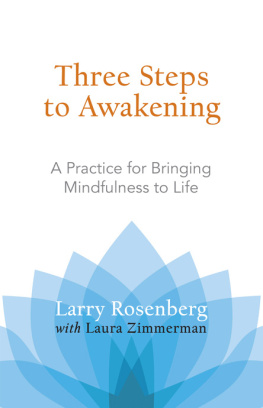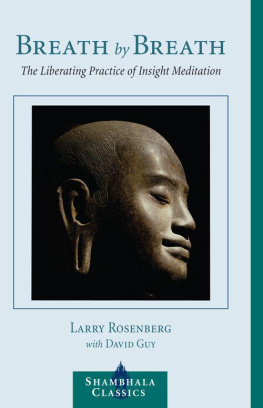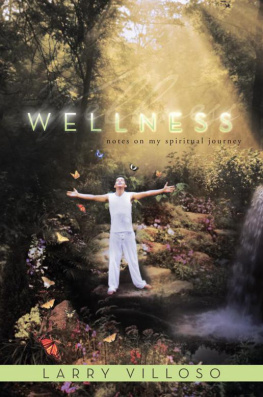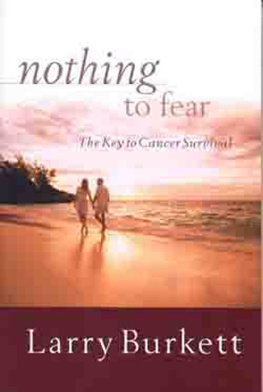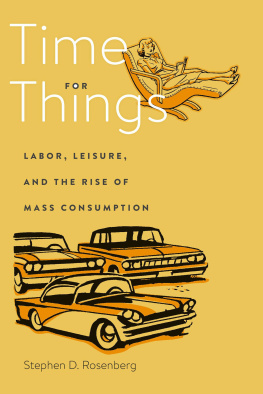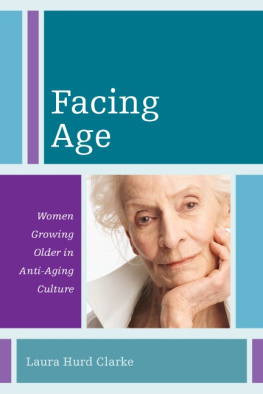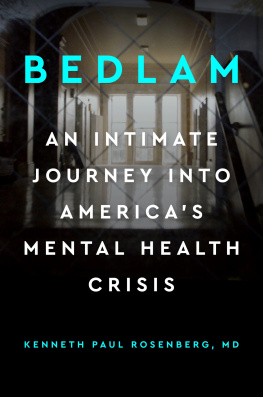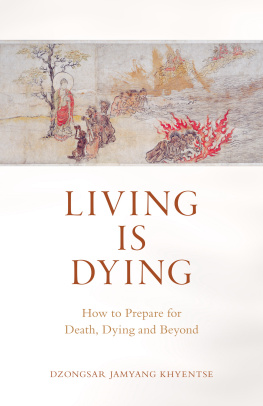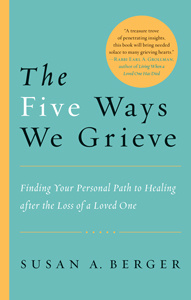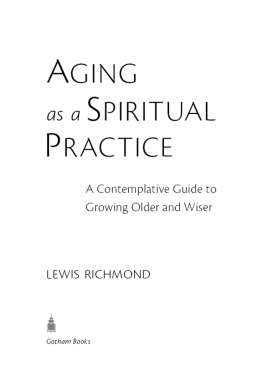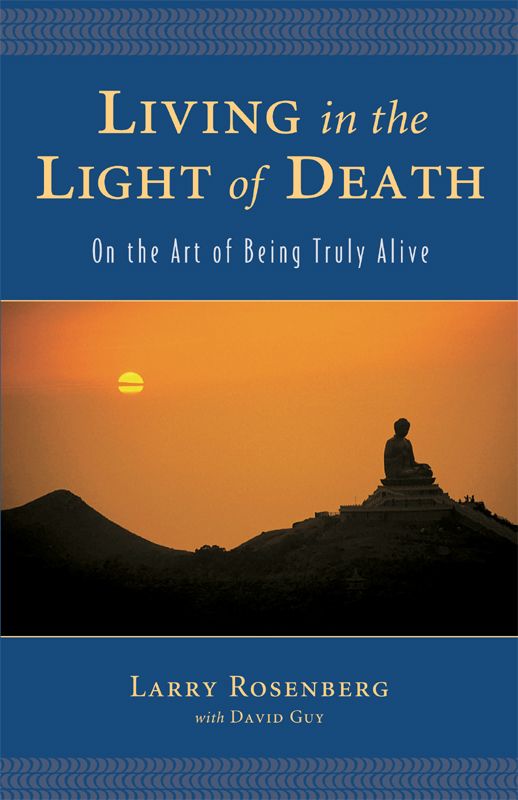Living in the Light of Death is an invaluable primer for virtually anyone who has a body and is old enough to read. Larry Rosenberg dives right to the core of what it takes to be truly alive and, with the lightest and kindest of touches, shows us simple ways to wake up to our lives while we have them to live. A true vehicle for exploring the profound question of whether there is life before death.
Jon Kabat-Zinn, author of Full Catastrophe Living and Wherever You Go, There You Are
ABOUT THE BOOK
This book presents the Buddhist approach to facing the inevitable facts of growing older, getting sick, and dying. These tough realities are not given much attention by many people until midlife, when they become harder to avoid. Using a Buddhist text known as the Five Subjects for Frequent Recollection, Larry Rosenberg shows how intimacy with the realities of aging can actually be used as a means to liberation. When we become intimate with these inevitable aspects of life, he writes, we also become intimate with ourselves, with others, with the worldindeed with all things.
LARRY ROSENBERG is founder and resident teacher of the Cambridge Insight Meditation Center in Cambridge, Massachusetts, and a guiding teacher at the Insight Meditation Society in Barre, Massachusetts.
Sign up to receive news and special offers from Shambhala Publications.

Or visit us online to sign up at shambhala.com/eshambhala.
LIVING
IN THE LIGHT
OF DEATH
On the Art of Being Truly Alive
Larry Rosenberg
with David Guy

S HAMBHALA
Boston & London
2013
Shambhala Publications, Inc.
Horticultural Hall
300 Massachusetts Avenue
Boston, Massachusetts 02115
www.shambhala.com
2000 by Larry Rosenberg
THE LIBRARY OF CONGRESS CATALOGUES THE HARDCOVER EDITION OF THIS TITLE AS FOLLOWS:
Rosenberg, Larry.
Living in the light of death: on the art of being truly alive/
Larry Rosenberg with David Guy
p. cm.
Includes bibliographical references.
eISBN 978-0-8348-2470-6
ISBN 978-1-57062-425-4 (cloth)
ISBN 978-1-57062-820-7 (paperback)
1. Spiritual lifeBuddhism. 2. AgingReligious aspectsBuddhism. 3. BuddhismDoctrines. I. Guy, David. II. Title.
BQ5395.R67 2000
294.3444dc21
99-058716
Three people very dear to me died before the completion of this book. My parents, Nathan and Anna Rosenberg; and my stepdaughter, Irina Moyseev. I dedicate any merit that may arise from this text to them. May it be of some benefit in their journey.
One purpose of our practice is to enjoy our old age. But we cant fool ourselves. Only sincere practice will work.
SHUNRYU SUZUKI ROSHI
Make good medicine from the suffering of sickness.
KYONG HO
One learns the art of dying by learning the art of living: how to become master of the present moment.
S. N. GOENKA
It is usually proclaimed eloquently that birth, aging, and death are suffering. But birth is not suffering, aging is not suffering, death is not suffering where there is not attachment to my birth, my aging, my death. At the moment, we are grasping at birth, aging, pain, and death as ours. If we dont grasp, they are not suffering, they are only bodily changes.
AJAAN BUDDHADASA
CONTENTS
In the Buddhas teaching, everything is a dependent arising: If something appears, it is due to certain causes and conditions. This book is no exception. So many things had to come together for it to happen. I will mention only a few.
More than twenty-five years ago, J. Krishnamurti and Vimala Thakar taught me that learning how to live and learning how to die were inseparable. In fact, they are the same thing. They started me off on the right foot, and I am grateful.
My editor at Shambhala Publications, Dave ONeal, was present at a series of talks that I gave on death awareness some years ago at the Cambridge Insight Meditation Center. He introduced himself and confidently informed me that the talks could easily be the basis for a book of some use to meditators. He then brilliantly helped the manuscript assume its present form.
My dear friend Jacalyn Bennett constantly encouraged me to turn these oral teachings into book form. She also, in a most gracious and unassuming manner, provided the financial support necessary to complete this project.
Yogis at the Cambridge Insight Meditation Center devoted many hours of their time to the accurate transcription of all my talks on death awareness. David Guy took this massive amount of material and artfully shaped it into a working document, maintaining with great sensitivity the spirit of the original talks. My wife, Galina, in her characteristically humorous and affectionate way, helped me know when to leave the computer and when to start in again. She was of immense help.
Words from the Pali language used in the text are defined where they are used and in the glossary. But a few Mahayana Sanskrit words have become so familiar to readers of Buddhist books in the English language that we have used the Sanskrit for those words rather than the Pali. We therefore refer to a sutra rather than a sutta, to the dharma rather than the dhamma, and to karma rather than to kamma.
Aging and Death, Our Lifelong Companions
Aging, illness and death are treasures for those who understand them. Theyre Noble Truths, Noble Treasures. If they were people, Id bow down to their feet every day.
AJAAN LEE
M Y MOST memorable learning experience about aging took place when I myself was still rather young, in my early thirties. I had been through college and graduate school and had become an academic. I had encountered a surprising amount of disappointment with that profession, perhaps because Id expected so much from it.
At that point I had the good fortune to meet my first spiritual teacher, J. Krishnamurti, and began discovering that my true interests were in abandoning my success ethic and getting sane. I began to search inwardly and had some powerful experiences that changed how I viewed exclusively intellectual work.
Krishnamurti is famous for saying that truth is a pathless way, but I soon realized that I needed a path, and a discipline. I began by studying yoga, which had great appeal to me. One summer I was at an ashram in Canada, attending a yoga camp, when I met an elderly man who would be very important in teaching me how to live, and age, gracefully.
His name was Shivananda Saraswati, and he was eighty-six years old, though he certainly didnt look it. He had an extremely dignified bearing, a beautiful complexion, and tremendous energy. He wasnt a teacher at the camp, though he showed us a few yoga postures. He actually lived in India, somewhere near the Himalayas, and was a lifelong monk, a teacher of Vedanta, which was a Hindu discipline. He had four students in North America, whom he taught by correspondence for many years, and they had pooled their money and paid for him to come over. He was traveling around to see them. One of the students was Canadian, which was how Shivananda Saraswati happened to be at the ashram.
He seemed more interesting than the other teachers there, so I began spending most of my time with him. Finally I decided to travel with him. He obviously had a great deal to teach me. We traveled by Greyhound bus, stopping at private residences, and I served as his attendant. I got to know him quite well.


